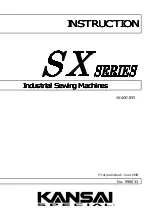
Ricoma Quick Start Guide
14
TIP:
If you run out of thread completely on a needle bar, re-thread, matching the thread path to a correctly
threaded neighboring needle bar.
INSTALLING THE NEEDLE
Selecting a needle
Choosing the right needle is important to ensure quality stitches. Embroidering with a needle that is
too small or too big for the thread and/or fabric may result in thread breaks or skipped stitches. There
are three things to consider when choosing the right needle for the job: finish, size and point. DBxK5 is
an established standard system for machine embroidery. This style needle has a medium point with a
larger eye, which allows the thread to flow smoothly and helps reduce thread breaks. Its only downfall
is that it is slightly less durable due to its thinner eye wall. A size 75/11 sharp point needle will work for
most embroidery projects. However, a general rule of thumb is to use ball point needles for knits and
sharp point needles for woven fabrics.
Tip:
In order to puncture the smallest hole possible, always use the smallest needle you can get away
with. Heavier materials cause the needle to bend, or deflect. This causes needle breaks, thread breaks,
missed stitches and other issues. We control the needle deflection by slowing down the speed of the
machine and/or changing the size of the needle.
Figure 24.
11. Now it’s time to thread the needle. Pass the thread through the eye of the needle from the front to
the back. To ensure your needle is placed correctly, make sure the curved side is facing the back.
Then, pass the thread through the presser foot. See point L in Figure 24.
12. Now, you can pull the thread back up, and rest your thread on the spring until you’re ready to
embroider. We recommend leaving one to two inches of thread hanging and trimming the excess.
This is optional, but will eliminate the need to snip the thread tail that will remain after the first
stitch is made while the thread tail is still held on the spring. See Figure 24.
13. Last, take a step back and look at the front of the machine to make sure that all needles appear to
be threaded correctly. If they seem to be uniform, you are ready to stitch a test pattern.
How to install the needle
When changing a needle, make sure the scarf of the needle is facing away from you and toward the
machine. When inserting the needle make sure it is completely straight and not slanted. If the needle is















































